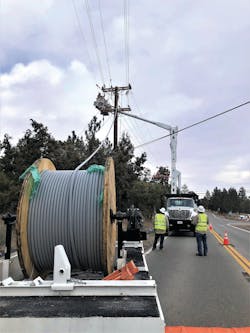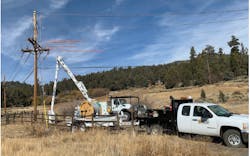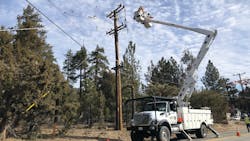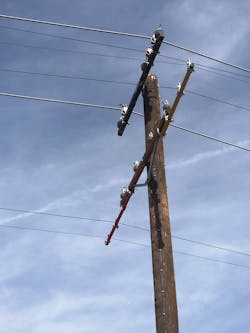Covered Wire Combats California Wildfires
Wildfires in the U.S. are now a year-round threat for many California communities like Big Bear and Bear Valley, the mountainous Southern California area serviced by Bear Valley Electric Services. Full of historic trees, dry brush and an aging grid, the utility’s territory has a very high fire risk.
Bear Valley Electric Services (BVES) has been laser focused on fire mitigation since 2018, when wildfires became catastrophic in California. As an investor-owned utility (IOU) in the state, BVES is required to file a Wildfire Mitigation Plan (WMP). The requirement was developed under regulatory discretion by the California Public Utilities Commission (CPUC) and designated by Senate Bill 901. It was signed into law in September 2018 as an amendment to Public Utilities Code 8386.
BVES strives to exceed requirements in its WMP by using a variety of safety, fire-hardening and grid-hardening strategies to reduce and eliminate the risk of wildfires. As drought and dryness are expected to continue across California for years to come, the utility is taking measures to protect lives and the land. For example, BVES became the first IOU in the U.S. to install fire-resistant-non-propagating (FR-NP) covered wire across its service territory. The FR 394.5 all-aluminum alloy conductor (AAAC) wire replaced existing 34-kV lines running throughout the utility’s high fire-threat areas, such as the San Bernardino National Forest and Bear Valley mountains.
Inventing a Covered Conductor
In 2018, when wildfires were destroying the lives and livelihood of thousands of people across California, utilities began looking at covered conductor as a method to reduce fires. At the same time, Priority Wire & Cable Inc. (PW&C) began exploring new products and designs to meet the needs of utilities searching for ways to combat wildfires. Brian Yu, vice president, engineering and international operations at PW&C, recognized a potential flaw in the approach most utilities were adopting. This is when the idea was born to design a new FR-NP covered wire technology that specifically would deter the spread of wildfires, mitigate their impacts and, ultimately, help utilities to address them.
The challenge with traditional utility distribution wires and cables is multiple environmental and durability factors — including sunlight and weather resistance, dielectric strength, tracking resistance, the ability to withstand thermostress and the safety of personnel — impact their effectiveness.
Standard covered wires are made of thermoplastic or cross-linked polyethylene. They do not have any flame resistance, so they burn readily. As they burn, they drip flaming particles onto the brush underneath the wire, which can cause secondary fires, especially in rural and wooded areas like Bear Valley. Not only does the thermoplastic or cross-linked polyethylene drip, but the fire propagates horizontally along the line of cable.
In contrast, the FR-NP covered wire from PW&C is designed to greatly reduce the spread of wildfires along distribution lines by reducing the opportunity for secondary fires, caused by the horizontal propagation and dripping of flaming material in traditional covered wires. The patent-pending technology exhibits self-extinguishing properties under typical wildfire conditions and is formulated using a special jacketing material that meets environmental, physical and dielectric property challenges. It also has successfully passed and exceeded the Underwriters Laboratories (UL) vertical flame tests FT1 and VW-1 and horizontal flame test FT2.
An added benefit of FR-NP protection is it enables utilities to maintain their power supply much longer during a fire. Therefore, they can restore power to affected communities much faster.
Innovation Implementation
BVES first discovered the technology by meeting with Nate Schwegman and Steve Lesch from Pacific Power Reps (PPR), a manufacterer’s representative company, at an industry trade show. At the time, PPR was working with the California Department of Forestry and Fire Protection on a product demonstration for the PW&C FR-NP covered wire. Following the event, a BVES supervisor introduced it to his team for investigation, and they looked further into the testing.
PPR, Wesco Distribution and PW&C organized a demonstration to showcase what happens to standard covered wire when it is ignited. Because it can drip flaming compound on the ground underneath, it can quickly exacerbate a utility’s problem regarding fire mitigation. After the demonstration, the BVES team decided to incorporate FR-NP covered wire into the pilot portion of its WMP.
BVES first tested the wire with a 10,000-ft installation pilot in a high-fire-risk area of its service territory in the fall of 2019. Once the utility saw the value FR-NP covered wire provided, it moved forward with the next round of the pilot, installing 120,000 ft of covered wire down Highway 18, one of the three exit routes from Big Bear mountain.
BVES had a crew of linemen on each side of the project connecting the new FR-NP covered line wire to the existing wire to feed it through the system. Two linemen were in the air at each end of the line while one lineman stayed in the reel trailer and another was stationed on the pulling trailer. Also, one lineman stayed at each end working as groundmen for the linemen in the air, and one crew foreman oversaw the installation.
Installing the Cable
When installing the FR-NP covered wired across its high-risk-fire territory, BVES first needed to secure the proper equipment. The installation of the FR-NP covered wire requires a different type of preparation using a specific stripping tool, similar to that used when stripping insulation on underground cross-linked polyethylene cable.
BVES had to assemble the right crew for the job. Under the direction of the field operations supervisor, BVES ensured the most knowledgeable crew members were placed on the job for the installation. Next, the IOU had to use due diligence in planning and designing for the heavier weight load of covered wire vs. traditional wire as well as wind loading. The crew adjusted span distances between poles to compensate for the slight increase in weight of the covered conductor. Because wind loading is mandatory in California for pole loading, this was one method to ensure the utility met or exceeded the CPUC’s General Order 95 wind loading safety factors.
Once the crew made the necessary adjustments, installation was simple and like that of most any covered wire. Any challenges stemmed from the fact the BVES territory is a mountainous area where snow, rainstorms and other weather events are the main deterrent.
To dispatch its crews, BVES scheduled around weather conditions. The realistic window for fire hardening at BVES is April through October, but it always strives to stay ahead of its fire-hardening plan and remain proactive when implement- ing its strategies. Regardless of the time of year, the utility took the opportunity to install the new wire at the first signs of a clear day.
Looking Ahead
The utility’s primary focus is safety and, as such, the reason it is installing the FR-NP covered wire is to stop or slow the spread of wildfire, increase the safety of its community, crews and firefighters, and mitigate any potential for fire reaching other areas inside or outside the Big Bear area.
BVES based each of its fire-hardening strategies on the threat to its specific terrain and makeup of its tight-knit community. For example, during the pilot project, the utility covered its high-vegetation field areas that could provide the most fire-hazard fuel should a wildfire break out.
In addition, BVES crews now are installing FR-NP covered wire on the remaining exit routes out of Bear Mountain. By keeping Highway 18 open during installation, the fire marshals and residents have access to the exit routes in the valley so they do not become trapped by a growing wildfire.
Now that BVES has installed the first two sections of the pilot project, the utility is seeing greater interest from its investors and other utilities that are interested in learning more about the covered wire technology. Often, larger IOUs are the first to test and install new innovations, but BVES opted to install the FR-NP covered wire ahead of other IOUs to provide an extra layer of protection the 24,000 year-round residents and 100,000+ weekend visitors who travel to Big Bear mountain for recreation year-round. Because the utility’s linemen and other employees live in Bear Valley, they are doubly invested in the program to keep the community safe.
The FR-NP covered wire is just one of the solutions BVES is implementing for its fire-hardening strategies. The utility, which operates primarily in a national forest with aging trees and an aging grid, has replaced many of its wooden crossarms with fire-resistant composite crossarms from Creative Pultrusions and invested in fire-resistant fiberglass and steel poles. In addition, its linemen have installed transformers with internal fault detectors (IFDs), emission-limiting fault fuses, ClampStar fire-resistant splice and connector clamps.
While most of the efforts are common-sense upgrades given BVES’s current state of wildfire threat, some require new mitigation efforts, forward-thinking and innovative technology as well as new ways of operating the system. For example, the utility’s smart weather stations communicate in real time. The utility also plans to install system-wide grid automation on its 34-kV system in 2020.
Looking to the future, BVES is focused on the mitigation of wildland fires by implementing a variety of fire-hardening strategies. In a short period of time, the IOU has made strides in its WMP, and it is continuing to work to put an end to devastating wildfires in California, but it cannot do it alone. Fire hardening is a team effort, and utilities must be in it together for their customers and their communities.
Editor’s Note: View a video at www.youtube.com/watch?v=FbT9iQzyp20 or visit www.tdworld.com/wildfire to view a photo gallery of BVES installing the FR-NP wire on a pilot project.
For more information:
Bear Valley Electric Services | www.bves.com
PPR | https://ppreps.com
PW&C | www.prioritywire.com
Taking a Proactive Approach
Beyond replacing traditional wire with covered wire in a pilot program, Bear Valley Electric Services (BVES) also has implemented the following programs to further safeguard its mountainous territory from wildfires:
1. Vegetation Management. Arborists are cutting back trees and limbs to a minimum radial clearance of 72 inches (6 ft) from conductors, going beyond the state standard of 48 inches (4 ft).
2. Suspect Tree Removal Program. Vegetation management professionals are removing all dead and rotting trees as well as those with the potential to fall on lines, even if they are outside the required clearance zone.
3. Equipment Upgrades. BVES has installed 10 weather stations in high-fire-threat areas and will install 10 additional units to assist in monitoring weather patterns and collecting real-time data.
4. Tree Attachment Removal. Crews are removing all pieces of electrical infrastructure fastened to trees for BVES first tested the wire with a 10,000-ft installation pilot in a high-fire-risk area of its service territory in the fall of 2019 infrastructural support to reduce the risk of hot equipment making contact with trees.
5. System-Wide Grid Automation. To expedite the detection and isolation of system faults, the utility is enabling remote monitoring of the grid.
6. Operational Improvements. To ensure pole failures are identified and addressed faster, BVES is increasing the number of power poles it evaluates each year to 2000 through its pole loading and asset remediation program. The utility also is intensifying its overhead line predictive maintenance program by using infrared sensors to identify locations in overhead lines at risk of failure.
7. Public Power Safety Shutoffs. BVES has permission from the state of California to proactively shut off power in high-risk areas during extreme weather conditions to reduce the risk of wildfire and protect the safety of customers, its families and property. Should deenergization take place, BVES alerts customers, local government and safety officials while keeping the community updated on evolving weather conditions.
About the Author
Eric Cardella
Eric Cardella is the engineering and planning supervisor for Bear Valley Electric Services.
Jeffrey Barber
Jeffrey Barber is the field operations supervisor for Bear Valley Electric Services.






